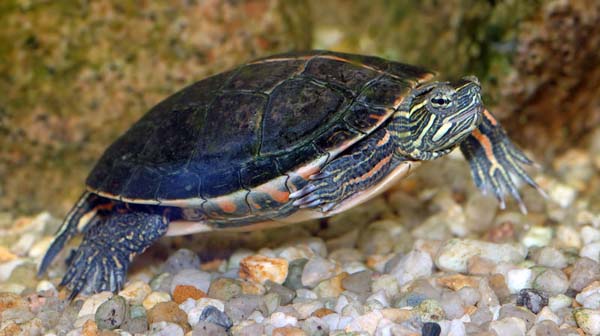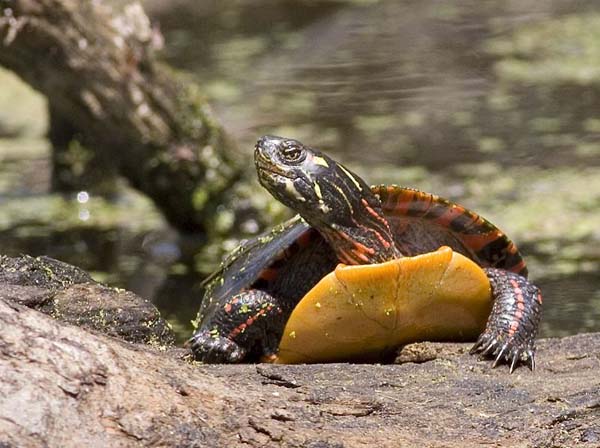Wildlife North America . com North American Animals - mamals, birds, reptiles, insects |
Painted Turtle (Chrysemys picta)
male Southern Painted Turtle (Chrysemys picta dorsalis) Photograph by André Karwath. Some rights reserved. (view image details) 
Female Painted turtle Photograph by Jmalik. Some rights reserved. (view image details)
PAINTED TURTLE FACTS
DescriptionThe Painted Turtle has a black or greenish brown carapace with some red and yellow markings around the shell. The underside or plastron is yellow-orange with fine markings, looking like it has been painted. The plastron can be solid yellow, yellow with small pattern in the center, or intricately patterned in yellow and red. The head and legs have yellow or red lines. The skin varies from olive green to black. There are four sub-species - Eastern, Southern, Midland, and Western painted turtles. Size carapace length - 25 cm Environment ponds, lakes, marshes, slow-moving rivers with soft, muddy bottoms. The painted turtle spends most of its time in water, but can often be seen basking in the sun on floating logs or rocks by the shore. Food Painted turtles eat plants, small fish, crustaceans, aquatic insects, and some carrion. Hatchlings have a more carnivorous diet, and eat larvae, insects, small worms and maggots. As they grow older, turtles eat more plant material. Breeding Painted Turtle breed from late spring to early summer. Females dig a nest in soft, sandy soil with good exposure to the sun, usually within 200m of water. The nest is shallow - only about 10cm - 12cm. She lays 4 - 15 oval, soft shelled eggs, and may lay up to five clutches per season. After laying the eggs are covered with dirt or sand and left unattended. The eggs hatch 72 to 80 days. Once the young hatch and dig out of the nest, they are independent. Range The Painted Turtle is found in southern Canada, the United States, and northern Mexico Notes Painted turtles can be kept in captivity in aquarium of at least 40 gallon capacity. They need a ramp and land area to bask out of the water. A UVA/UVB light is required to provide heat and light for basking and healthy development. The tank should be cleaned at least weekly and good water filtration system should be used. Classification
Home | Mammals | Reptiles | Birds | Insects | Privacy Policy | Disclaimer | Contact Us |